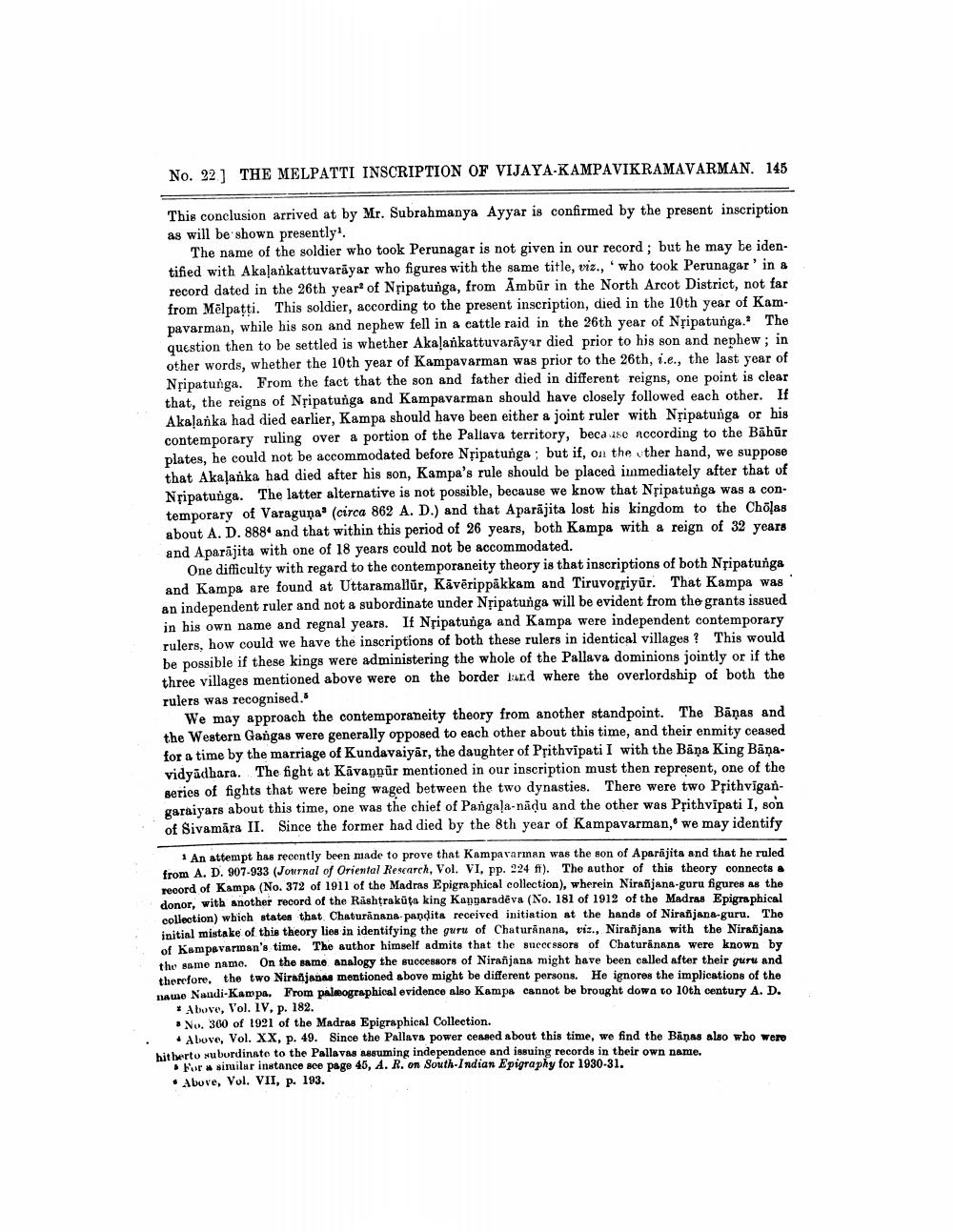________________
No. 22) THE MELPATTI INSCRIPTION OF VIJAYA-KAMPAVIKRAMAVARMAN. 145
This conclusion arrived at by Mr. Subrahmanya Ayyar is confirmed by the present inscription as will be shown presently!
The name of the soldier who took Perunagar is not given in our record; but he may be identified with Akaļankattuvarāyar who figures with the same title, viz., 'who took Perunagar'in & record dated in the 26th year of Nřipatunga, from Ambūr in the North Arcot District, not far from Mēlpaţti. This soldier, according to the present inscription, died in the 10th year of Kampavarman, while his son and nephew fell in a cattle raid in the 26th year of Nřipatunga. The question then to be settled is whether Akaļankattuvarāyar died prior to his son and nephew; in other words, whether the 10th year of Kampavarman was prior to the 26th, i.e., the last year of Nțipatunga. From the fact that the son and father died in different reigns, one point is clear that, the reigns of Nřipatunga and Kampavarman should have closely followed each other. If Akalanka had died earlier, Kampa should have been either a joint ruler with Nřipatunga or his contemporary ruling over a portion of the Pallava territory, because according to the Bāhūr plates, he could not be accommodated before Nřipatunga ; but if, on the uther hand, we suppose that Akaļanka had died after his son, Kampa's rule should be placed immediately after that of Nțipatunga. The latter alternative is not possible, because we know that Nripatunga was a contemporary of Varaguna' (circa 862 A. D.) and that Aparajita lost his kingdom to the Cholas about A. D. 8884 and that within this period of 26 years, both Kampa with a reign of 32 years and Aparajita with one of 18 years could not be accommodated.
One difficulty with regard to the contemporaneity theory is that inscriptions of both Nřipatunga and Kampa are found at Uttaramalūr, Kävērippakkam and Tiruvorriyūr. That Kampa was an independent ruler and not a subordinate under Nřipatunga will be evident from the grants issued in his own name and regnal years. If Nripatunga and Kampa were independent contemporary rulers, how could we have the inscriptions of both these rulers in identical villages ? This would be possible if these kings were administering the whole of the Pallava dominions jointly or if the three villages mentioned above were on the border and where the overlordship of both the rulers was recognised.
We may approach the contemporaneity theory from another standpoint. The Bānas and the Western Gangas were generally opposed to each other about this time, and their enmity ceased for a time by the marriage of Kundavaiyār, the daughter of Přithvipati I with the Bāņa King Bāņavidyadhara. The fight at Kävangur mentioned in our inscription must then represent, one of the series of fights that were being waged between the two dynasties. There were two Prithvigangaraiyars about this time, one was the chief of Pangaļa-nadu and the other was Prithvipati I, son of Sivamira II. Since the former had died by the 8th year of Kampavarman, we may identify
1 An attempt has recently been made to prove that Kampavarnan was the son of Aparajita and that he ruled from A. D. 907-933 (Journal of Oriental Research, Vol. VI. pp. 224 ff). The author of this theory connects a record of Kampa (No. 372 of 1911 of the Madras Epigraphical collection), wherein Niralijana-guru figures as the donor, with another record of the Rashtrakūta king Kapparadeva (No. 181 of 1912 of the Madras Epigraphical collection) which states that Chaturanana pandita received initiation at the hands of Nirajana.guru. The initial mistake of this theory lies in identifying the guru of Chaturanana, vis., Nirajans with the Nirajana of Kampavarman's time. The author himself admits that the successors of Chaturanana were known by the same name. On the same analogy the successors of Nirajana might have been called after their guru and therefore, the two Nirajanas mentioned above might be different persons. He ignores the implications of the name Nandi-Kampa. From palmographical evidence also Kamps cannot be brought dowa to 10th century A. D.
*Above, Vol. IV, p. 182. No. 300 of 1921 of the Madras Epigraphical Collection.
Above, Vol. XX, p. 49. Since the Pallava power ceased about this time, we find the Banas also who were hitberto subordinate to the Pallavas nasuming independence and issuing records in their own name.
For similar instancesce page 45, A. R. on South Indian Epigraphy for 1930-31. Above, Vol. VII, p. 193.




